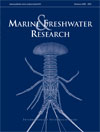Marine and Freshwater Research
Volume 63
Number 5 2012
Painted spiny lobster is a popular seafood on coral reefs, but little is known about the biology and fisheries of this species, which increases the risk of over-fishing. We quantified important demographic and fishery-related parameters of painted spiny lobster and subsequently demonstrate that current management regulations are suboptimal. Implementation of sound, knowledge-based management strategies is recommended to help ensure this important fishery resource is harvested on a sustainable and rational basis.
The pelagic larval duration of Kuhlia rupestris, widely distributed in the Indo-Pacific area, and K. sauvagii, restricted to the Indian Ocean, were investigated by otolith microstructure analysis. Daily increment formation was validated in K. rupestris. The results contribute to the understanding of dispersal strategies of freshwater fauna, to colonise and persist in tropical islands.
This is the first study to find photosynthetic bacteria in sponges from depths of 50 m and more in temperate seas anywhere in the world. We conducted a survey off south-western Australia and found sponges with high levels of photosynthetic bacteria up to 50 m, medium levels to 75 m and low levels to 150 m. Sponges make up very high biomass at depths of 30–150 m and these symbiotic bacteria may be important in facilitating sponges to dominate habitats at these depths.
Terrestrial food subsidies are important to fish across different ecosystems. By assessing the importance of terrestrial subsidies in non-salmonid fishes, we found that cyprinids and fundulids, as well as fishes with terminal jaw positions, tended to consume the most terrestrial subsidies. Our findings justify focussing on trophic linkages between fishes and riparian systems across a wide range of taxa.
Climate change is expected to affect marine organisms; developing future scenarios of these biological responses help assess their potential impacts and implications for ecosystem goods and services. Our study shows that the Western Australian coast is expected to experience a ‘tropicalisation’ of the marine community in the next few decades. Such ‘tropicalisation’ is caused by southward shift of species distributions around Australia. The results help identify sensitive marine species and areas to climate change, and to inform, mitigate and adapt policies.
This study sought to fill a gap in knowledge of invertebrate colonisation of detritus in tropical streams. The aim was to assess the effects of form, size and quality of leaf detritus on invertebrate colonisation in the Cerrado, Brazil. Our results suggest that the lack of shredders in this system may be related to the effect of the natural selection exercised by the chemical composition of tropical plant species.
Man-made instream structures cause barriers to fish migration in waterways around the world, impacting on the reproductive success of fish species. This study demonstrates the use of a novel technique to enable fish with climbing abilities access past perched culverts. The use of ropes at barriers is an inexpensive, rapid and potentially effective retrofit option for culverts for increasing upstream migration of juvenile fish and ultimately improving overall ecosystem health.
The particular Pleistocene glacial cycle associated with past connectivity in freshwater species across the Carpentaria region of northern Australia is debated. We used statistical phylogeography to test alternative periods of past connectivity in Glossamia aprion; results supported the mid- to late- Pleistocene. Findings are interpreted in relation to phylogeographic patterns for other aquatic species, and synthesised biogeographic hypotheses are proposed.
Cyanobacterial mats cover extensive areas of arid coastal wetlands. The present study investigates nutrient exchange of cyanobacterial mats during an unusual period of heavy rainfall. Cyanobacterial mats incorporated nutrients through N-fixation and nutrient removal from the floodwater. Highest incorporation rates were measured in the low intertidal during the day. Cyanobacterial mats could play an important role in coastal production of arid oligotrophic regions.
Coral fishing has generated international discussion because of a serious decline in its abundance caused by overfishing. Our investigation on Japanese red coral off Amami Island, Southern Japan, reveals that harvested populations need a minimum of 10–20 years to return to the pre-fishing level. This indicates the sustainable management of this resource could be achieved with a rotational harvest.




